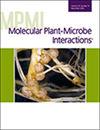Xiaoxiao Zhang, Bayantes Dagvadorj, Jialing Gao, Lucy M Molloy, Lauren M Crean, Simon J Williams, John P Rathjen
求助PDF
{"title":"大麦Mla NLR基因体外重组鉴定效应物结合的关键功能获得残基","authors":"Xiaoxiao Zhang, Bayantes Dagvadorj, Jialing Gao, Lucy M Molloy, Lauren M Crean, Simon J Williams, John P Rathjen","doi":"10.1094/MPMI-11-24-0146-R","DOIUrl":null,"url":null,"abstract":"<p><p>Natural plant populations maintain high resistance (<i>R</i>) gene diversities that provide effective pathogen resistance; however, agricultural crops typically contain limited <i>R</i> gene diversity, so resistance is often short-lived, as pathogens evolve rapidly to evade recognition. The <i>Mildew resistance locus A</i> (<i>Mla</i>) <i>R</i> gene family of barley and wheat represents a rich source of natural genetic variation that is ideal for mining disease resistance specificities. <i>Mla R</i> genes encode immune receptor proteins of the nucleotide-binding leucine-rich repeat class that recognize unrelated plant pathogens by binding secreted virulence proteins termed effectors. Using DNA shuffling, we generated a variant library by recombining the barley <i>Mla7</i> and <i>Mla13</i> genes in vitro. The variant library was cloned into yeast generating approximately 4,000 independent clones and was screened for interaction with corresponding barley powdery mildew effectors AVR<sub>A13</sub> and AVR<sub>A7</sub> using a yeast two-hybrid assay. This yielded a number of MLA protein variants that interacted with AVR<sub>A13</sub>. Sequences of the interacting MLA variants can be clustered into three groups, all of which contain a critical residue from MLA13. Although MLA13 and MLA7 differ by 30 residues across the leucine-rich repeat domain, the replacement of leucine with serine at this position in MLA7 is necessary and sufficient for interaction with AVR<sub>A13</sub> in yeast and AVR<sub>A13</sub>-dependent immune signaling in planta. We have established a pipeline that evolves MLAs to recognize distinct pathogen effectors without the requirement for protein structural knowledge and the use of rational design. We suggest that these findings represent a step toward evolving novel recognition capabilities rapidly in vitro. [Formula: see text] Copyright © 2025 The Author(s). This is an open access article distributed under the CC BY-NC-ND 4.0 International license.</p>","PeriodicalId":19009,"journal":{"name":"Molecular Plant-microbe Interactions","volume":" ","pages":"454-462"},"PeriodicalIF":3.4000,"publicationDate":"2025-05-01","publicationTypes":"Journal Article","fieldsOfStudy":null,"isOpenAccess":false,"openAccessPdf":"","citationCount":"0","resultStr":"{\"title\":\"Identification of a Key Gain-of-Function Residue for Effector Binding by In Vitro Shuffling of Barley <i>Mla NLR</i> Genes.\",\"authors\":\"Xiaoxiao Zhang, Bayantes Dagvadorj, Jialing Gao, Lucy M Molloy, Lauren M Crean, Simon J Williams, John P Rathjen\",\"doi\":\"10.1094/MPMI-11-24-0146-R\",\"DOIUrl\":null,\"url\":null,\"abstract\":\"<p><p>Natural plant populations maintain high resistance (<i>R</i>) gene diversities that provide effective pathogen resistance; however, agricultural crops typically contain limited <i>R</i> gene diversity, so resistance is often short-lived, as pathogens evolve rapidly to evade recognition. The <i>Mildew resistance locus A</i> (<i>Mla</i>) <i>R</i> gene family of barley and wheat represents a rich source of natural genetic variation that is ideal for mining disease resistance specificities. <i>Mla R</i> genes encode immune receptor proteins of the nucleotide-binding leucine-rich repeat class that recognize unrelated plant pathogens by binding secreted virulence proteins termed effectors. Using DNA shuffling, we generated a variant library by recombining the barley <i>Mla7</i> and <i>Mla13</i> genes in vitro. The variant library was cloned into yeast generating approximately 4,000 independent clones and was screened for interaction with corresponding barley powdery mildew effectors AVR<sub>A13</sub> and AVR<sub>A7</sub> using a yeast two-hybrid assay. This yielded a number of MLA protein variants that interacted with AVR<sub>A13</sub>. Sequences of the interacting MLA variants can be clustered into three groups, all of which contain a critical residue from MLA13. Although MLA13 and MLA7 differ by 30 residues across the leucine-rich repeat domain, the replacement of leucine with serine at this position in MLA7 is necessary and sufficient for interaction with AVR<sub>A13</sub> in yeast and AVR<sub>A13</sub>-dependent immune signaling in planta. We have established a pipeline that evolves MLAs to recognize distinct pathogen effectors without the requirement for protein structural knowledge and the use of rational design. We suggest that these findings represent a step toward evolving novel recognition capabilities rapidly in vitro. [Formula: see text] Copyright © 2025 The Author(s). This is an open access article distributed under the CC BY-NC-ND 4.0 International license.</p>\",\"PeriodicalId\":19009,\"journal\":{\"name\":\"Molecular Plant-microbe Interactions\",\"volume\":\" \",\"pages\":\"454-462\"},\"PeriodicalIF\":3.4000,\"publicationDate\":\"2025-05-01\",\"publicationTypes\":\"Journal Article\",\"fieldsOfStudy\":null,\"isOpenAccess\":false,\"openAccessPdf\":\"\",\"citationCount\":\"0\",\"resultStr\":null,\"platform\":\"Semanticscholar\",\"paperid\":null,\"PeriodicalName\":\"Molecular Plant-microbe Interactions\",\"FirstCategoryId\":\"99\",\"ListUrlMain\":\"https://doi.org/10.1094/MPMI-11-24-0146-R\",\"RegionNum\":3,\"RegionCategory\":\"生物学\",\"ArticlePicture\":[],\"TitleCN\":null,\"AbstractTextCN\":null,\"PMCID\":null,\"EPubDate\":\"2025/6/6 0:00:00\",\"PubModel\":\"Epub\",\"JCR\":\"Q2\",\"JCRName\":\"BIOCHEMISTRY & MOLECULAR BIOLOGY\",\"Score\":null,\"Total\":0}","platform":"Semanticscholar","paperid":null,"PeriodicalName":"Molecular Plant-microbe Interactions","FirstCategoryId":"99","ListUrlMain":"https://doi.org/10.1094/MPMI-11-24-0146-R","RegionNum":3,"RegionCategory":"生物学","ArticlePicture":[],"TitleCN":null,"AbstractTextCN":null,"PMCID":null,"EPubDate":"2025/6/6 0:00:00","PubModel":"Epub","JCR":"Q2","JCRName":"BIOCHEMISTRY & MOLECULAR BIOLOGY","Score":null,"Total":0}
引用次数: 0
引用
批量引用

 求助内容:
求助内容: 应助结果提醒方式:
应助结果提醒方式:


